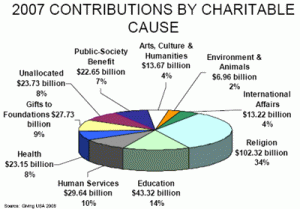Demographics – statistics and summations of fundraising populations – can be useful tools for targeting fundraising efforts. Making the most of fundraising demographics entails research and effective utilization of the statistics available.
Today’s Fundraising Demographics
Fundraising demographics are wide and varied and, like every year, come with some changes and surprises:
- According to the U.S. Department of the Interior’s Giving Statistics for 2007, private individuals and “household donors” make up the greatest proportion of charitable gifts (about 83%)
- Corporation grants and donations are good sources of funding, but make up only about 17% of all fundraising gifts and donations
- Individuals tend to choose a valued organization or effort and annually give to them; there is little shift from year to year between what groups receive what percentages of donations
- By cause, religious/faith-based groups, education-based groups, and human services organizations top the list for donations received, respectively
- Arts donors’ contributed the highest shares of their income, 2.1%.
- The so-called “baby-boomers” comprise one of the largest percentages of donors by generation
- Women are increasingly becoming the most charitable sex (in part because of increased income and affluence among women independently)

From the US Department of the Interior website.
Demographics are often used to target a specific, well-off segment of the supporting public so groups can plan campaigns accordingly, but they can also be used to see what donors are donating, not just who is giving the goods (because not all donations are cash donations). Fundraising demographics can be used to target a pool of potential volunteers and group members as well, which is essential to furthering any fundraising cause.
The demographics above are only the tip of the statistical fundraising iceberg. There are a number of demographics available from data collection services and agencies which can be tapped by organizations with specific goals, but…
A word of caution concerning fundraising demographics
Relying too heavily on fundraising demographics can be limiting. Some groups tend to be too specific in targeting fundraising efforts and miss a large segment of willing volunteers and supporters. As Terrence Fernsler says in a review in the “Nonprofit World” (Volume 14, No.4), “it can be a mistake to rely too heavily on demography.” For most fundraising groups, smaller organizations, schools, and teams in particular, appeals should be wide-reaching and inviting of all willing supporters. It would be nice to think that there was a magic population demographic to suit every funding need, but in reality the base is a mix for the majority of groups.
Unless it is known that a target population is very well-off and very willing to give, groups should be careful about putting all their eggs into the fundraising demographics basket. Demographics certainly have a usefulness and purpose, but taking them as gospel to fundraising success is risky. Fundraising planners need to incorporate fundraising demographics with past successes and failures to arrive at an equation that will equal fundraising success.
For more articles relating to supporters and donors, visit our “Donors” category.
